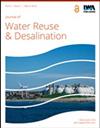采用循环模式:沙特阿拉伯将污水处理厂转变为资源回收设施的机遇和挑战
IF 2.3
Q2 Environmental Science
引用次数: 8
摘要
随着人口的不断增长,水、能源和资源需要谨慎使用、重复利用和更新。全球对从“废物”中回收资源越来越感兴趣,这是由可持续性和环境问题驱动的,也是由潜在的经济效益驱动的。废物(水)管理的一个新时代正在实现,通过将可重复使用的水的生产与能源和资源回收相结合,废水处理正在成为循环经济的一部分。从这个新的角度来看,废水不再被视为需要消耗能源进行处理的废物,而是淡水、能源、营养物质(氮和磷)和材料(如生物塑料、纤维素纤维和藻酸盐)的宝贵资源。在这篇综述文章中,将污水处理厂(WWTP)转变为资源回收厂(RRF)是沙特阿拉伯王国(KSA)实现水务部门循环经济的前进道路之一。文章中强调的一些先进技术可以安装、集成或改造到现有的污水处理厂中,以创建RRF,从而从城市废水中回收淡水、纤维素、藻酸盐类外聚合物(bio-ALE)和沼气,实现气候中和、脱碳和生产新的有前景的资源。这篇文章强调了使用可持续技术的模块化、适应性和/或分散式方法的必要性,如好氧颗粒污泥(AGS)-重力驱动膜(AGS-GDM)、厌氧电化学膜生物反应器(AnEMBR)和厌氧膜生物反应机(AnMBR),以利于局部水的再利用。重复使用的增加将减轻对不可再生水资源的压力,并减少对能源密集型海水淡化过程的依赖。本文还概述了KSA面临的水资源挑战,以及为应对这些重大挑战而开展的主要水资源研究计划/主题。本文章由计算机程序翻译,如有差异,请以英文原文为准。
Adopting the circular model: opportunities and challenges of transforming wastewater treatment plants into resource recovery facilities in Saudi Arabia
With the ever-growing population, water, energy, and resources need to be used carefully, reused, and renewed. There is an increasing global interest in resource recovery from ‘waste’, which is driven by sustainability and environmental concerns and motivated by the potential for economic benefits. A new era in waste (water) management is being realized where wastewater treatment is becoming part of the circular economy by integrating the production of reusable water with energy and resource recovery. In this new perspective, wastewater is no longer seen as a waste to be treated with energy expenditure but rather as a valuable resource of freshwater, energy, nutrients (nitrogen and phosphorous), and materials (e.g., bioplastics, cellulose fibres, and alginate). In this review paper, the conversion of wastewater treatment plants (WWTPs) into resource recovery factories (RRFs) is presented as one of the ways forward to achieve a circular economy in the water sector for the Kingdom of Saudi Arabia (KSA). The advanced technologies, some highlighted in the article, can be installed, integrated, or retrofitted into existing WWTPs to create RRFs enabling the recovery of freshwater, cellulose, alginate-like exopolymers (bio-ALE), and biogas from municipal wastewater achieving climate neutrality, decarbonization, and production of new and promising resources. The article highlights the need for modular, adaptive, and/or decentralized approaches using sustainable technologies such as aerobic granular sludge (AGS)-gravity-driven membrane (AGS-GDM), anaerobic electrochemical membrane bioreactor (AnEMBR), and anaerobic membrane bioreactor (AnMBR) for conducive localized water reuse. The increase in reuse will reduce the pressure on non-renewable water resources and decrease dependency on the energy-intensive desalination process. This article also outlines the water challenges that are arising in KSA and what are the major water research programmes/themes undertaken to address these major challenges.
求助全文
通过发布文献求助,成功后即可免费获取论文全文。
去求助
来源期刊

Journal of Water Reuse and Desalination
ENGINEERING, ENVIRONMENTAL-WATER RESOURCES
CiteScore
4.30
自引率
0.00%
发文量
23
审稿时长
16 weeks
期刊介绍:
Journal of Water Reuse and Desalination publishes refereed review articles, theoretical and experimental research papers, new findings and issues of unplanned and planned reuse. The journal welcomes contributions from developing and developed countries.
 求助内容:
求助内容: 应助结果提醒方式:
应助结果提醒方式:


